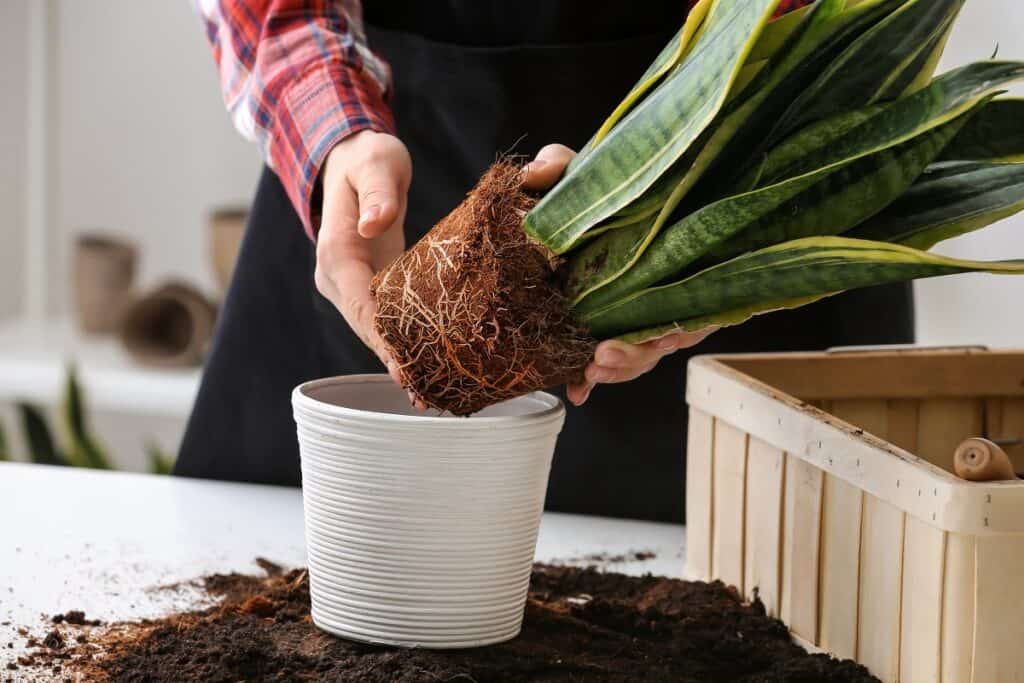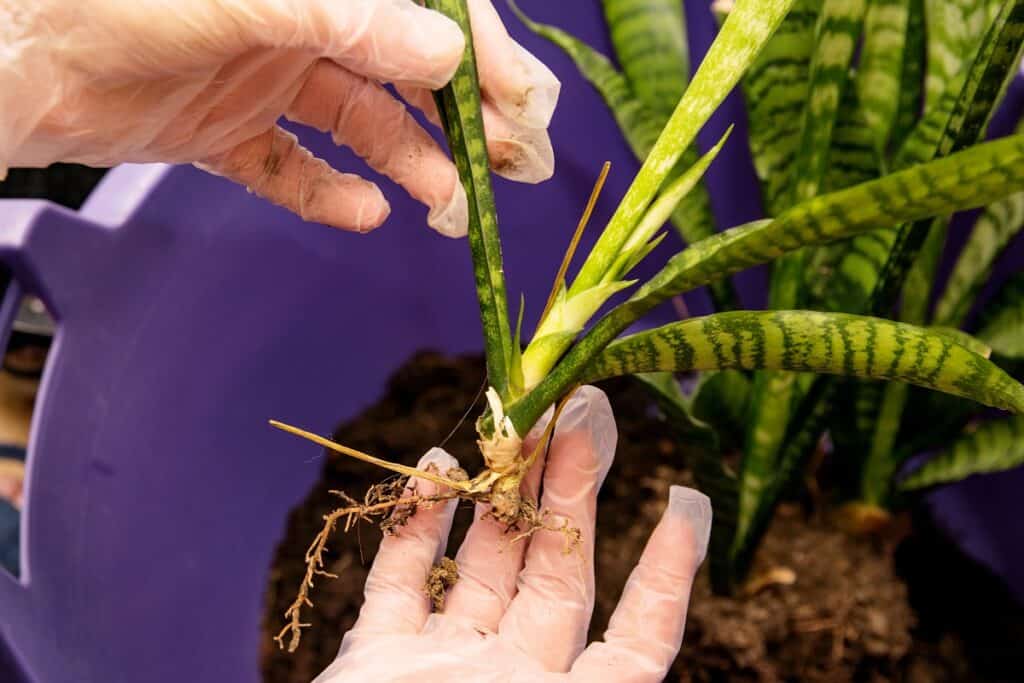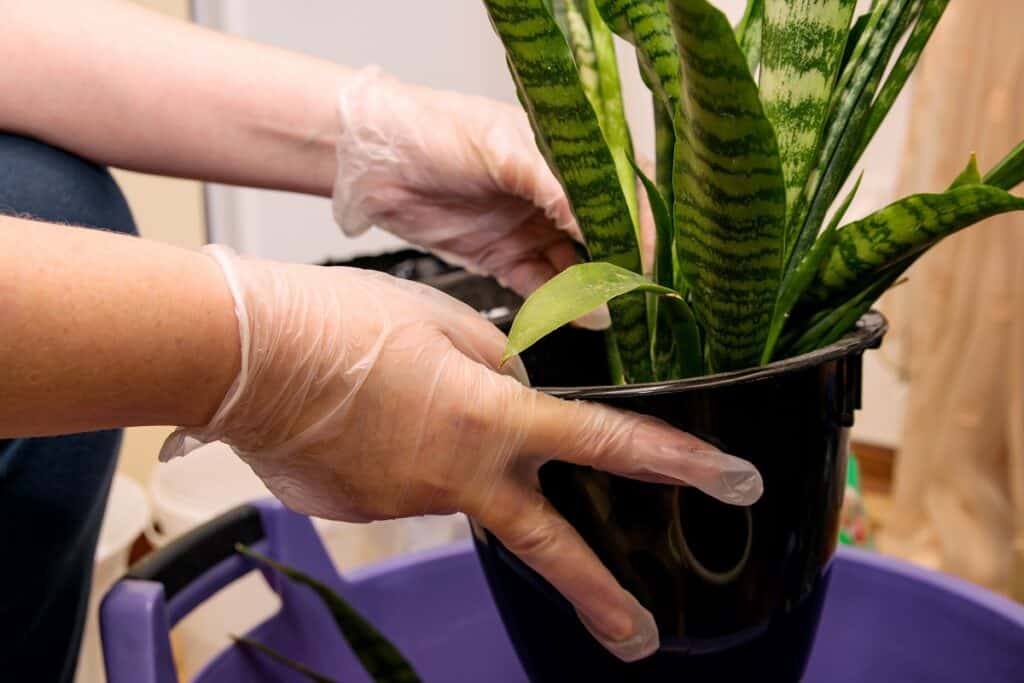Are you looking to propagate your snake plant or simply looking to divide it up and re-pot it? Either way, separating snake plants can be a simple and rewarding task. In this blog post, we will go over the steps for separating and propagating snake plants, as well as discuss some important considerations to keep in mind. So if you’re ready to learn how to separate snake plant, keep reading for all the information you need to get started!

Contents
- 1 Is It Easy To Separate A Snake Plant?
- 2 How To Separate Snake Plant
- 3 Do Snake Plants Like To Be Crowded?
- 4 How Do I Know If My Snake Plant Is Root Bound?
- 5 Can You Cut A Snake Plant Root In Half?
- 6 Can You Trim Snake Plant Roots?
- 7 Can Snake Plant Survive Without Roots?
- 8 Can You Replant Broken Snake Plant?
- 9 How Do You Repot A Snake Plant Without Killing It?
- 10 Should You Remove Snake Plant Pups?
- 11 When Should I Divide My Snake Plant Pups?
- 12 Conclusion
Is It Easy To Separate A Snake Plant?
Separating a snake plant can be a relatively easy task, as long as you have the right tools and follow the proper steps. Snake plants have relatively sturdy roots, which makes them relatively easy to divide. However, it is important to be gentle when handling the plant and its roots to avoid damaging them. If you are careful and take your time, separating a snake plant can be a simple and rewarding task.
It’s worth noting that snake plants can be slow to adjust to being re-potted, so you may need to be patient and give them time to recover after separating them. With proper care, however, your separated snake plants should soon start to thrive in their new homes.
How To Separate Snake Plant

The process of separating snake plants is fairly straightforward and can be done with a few basic tools. Here are the steps to follow:
- Water the plant thoroughly for a few days before separating it. This will help to moisten the soil and make it easier to work with.
- Gently remove the plant from its pot. If the plant is rootbound or the pot is difficult to remove, you may need to use a knife or scissors to cut the pot away.
- Carefully loosen the root ball to expose the individual roots.
- Use a sharp knife or scissors to divide the root ball into smaller sections, making sure each section has a good amount of roots and leaves.
- Re-pot the sections into separate pots or containers, using fresh potting soil.
- Water the plants well, and place them in a location with indirect light. Avoid exposing the plants to direct sunlight until they have had a chance to adjust to their new pots.
- Monitor the plants for the first few weeks, making sure to keep the soil moist but not soggy.

Do Snake Plants Like To Be Crowded?
Snake plants, also known as sansevieria or mother-in-law’s tongue, are relatively low-maintenance plants that are tolerant of a wide range of growing conditions. They are known for their ability to survive in relatively low light and dry soil conditions, and they are generally not fussy about being crowded.
However, while snake plants can tolerate being crowded, they will generally grow and thrive better when they have enough space to spread out. If you notice that your snake plant has become crowded in its pot or container, it may be time to consider separating it and re-potting it into a larger container. This will give the plant room to grow and will help to ensure that it receives the proper care and nutrients it needs to thrive.
How Do I Know If My Snake Plant Is Root Bound?
If your snake plant has become root bound, it means that the roots of the plant have become crowded and tangled in the pot, preventing the plant from getting enough water and nutrients. This can cause the plant to become stunted or stop growing altogether.
There are a few signs to look for to determine if your snake plant is root bound:
- The plant appears to be stunted or is not growing as it should.
- The leaves of the plant appear yellow or wilted, even when the plant is well-watered.
- The plant appears to be dry or wilted, even when the soil is moist.
- The plant is difficult to remove from its pot, or the roots are visibly crowded and tangled.
If you suspect that your snake plant is root bound, the best course of action is to re-pot it into a larger container. This will give the roots room to spread out and allow the plant to grow and thrive.
Can You Cut A Snake Plant Root In Half?
If you’re looking to separate your snake plant, one of the easiest methods is root division. This involves cutting the roots in half and replanting each half in its own pot.
While this method is relatively simple, it’s important to use the right tools. Snake plants have strong roots, so it’s best to use a clean, sharp garden knife or sterile knife. This will ensure that you don’t damage the root system when cutting.
Once the root has been cut in half, you’ll need to replant each half. This can be done using the division propagation technique, which involves planting each half in its own pot.
By taking the time to cut and replant your snake plant roots, you’ll be able to easily separate it into two plants. Just remember to use the right tools, and you’ll be on your way to a healthy, thriving snake plant.
Can You Trim Snake Plant Roots?

Once you’ve separated the snake plant, you may need to trim the roots. This is especially important if you’re repotting the plant into a smaller pot.
You’ll need a sharp utility knife or butter knife for this task, as this will ensure that you make a clean cut. Begin by removing any dead or damaged roots, and then trim back the healthy roots to the desired length.
When trimming the roots, be sure to leave enough root tissue to support the new plant. Make sure that the cuts are clean and even, as this will help the plant heal more quickly. After trimming the roots, you can transplant the new plants into their own containers.
Can Snake Plant Survive Without Roots?
Snake plants are known for their resilience, but can they survive without roots? The short answer is yes, they can! Snake plants can regenerate a new root system if their existing roots are damaged or removed.
If you have accidentally damaged the roots of your snake plant, it is important to act quickly to try and save the plant. The first step is to remove any damaged or diseased roots and repot the plant in fresh, well-draining soil. Water the plant well, and place it in a location with indirect light. Avoid exposing the plant to direct sunlight until it has had a chance to adjust to its new pot.
It may take several weeks or even months before new roots begin to form, so be sure to start this process before winter comes. Once the new roots have formed, be sure to give the plant a deep watering. This will help foster healthy root growth and ensure your snake plant has a strong root system.
Can You Replant Broken Snake Plant?
If you’ve recently tried separating your snake plant and ended up with a few broken pieces, don’t despair! You can still save your snake plant and replant it to give it a new life.
The first step is to prepare the broken pieces for replanting. Carefully remove any excess dirt and debris from the roots and leaves. Then, prepare a succulent potting mix with a moist potting soil mix.
You’ll want to replant the broken pieces as soon as possible, so it’s important to find a place with indirect sunlight for the snake plant. Place the pieces in the potting mix and lightly cover them with soil.
Once the replanting is complete, the snake plant should be given a few days to adjust to its new home. Avoid exposing it to direct sunlight during this time.
When the roots have formed after some time, you can slowly introduce the snake plant to more sunlight. Gradually expose it to more direct sunlight over time, as this will help it to adjust to its new environment and begin to thrive.
Replanting a broken snake plant may seem daunting, but with a little patience and the right potting mix, it’s a perfectly feasible task.
How Do You Repot A Snake Plant Without Killing It?

Once you’ve successfully separated your snake plant, it’s time to repot the individual sections. This can be a tricky task because you need to be careful not to damage the delicate roots of the snake plant. Here’s how to do it safely:
Start by choosing the right potting soil for your snake plant. For best results, opt for a succulent-style potting mix, houseplant potting mix, or a well-draining potting mix.
Next, take your pot and fill it about 2/3 of the way up with the chosen potting soil. Make sure the pot has a good drainage hole in the bottom to avoid over-watering.
Carefully remove the snake plant from its old pot and loosen the roots at the bottom. Place the snake plant into the new pot and fill the pot with potting soil until it’s full.
Once the snake plant is in its new pot, make sure it is sitting at the same level it was in the old pot. Gently press the soil down around the base of the plant to ensure it is firmly in place.
Finally, water your snake plant until the soil is moist but not soggy. Place the newly repotted snake plant in a container that is tall enough for its size and place it in a bright spot in your home.
By following these steps, you can successfully repot your snake plant without killing it. With the right potting soil and a bit of patience, you can keep your snake plant healthy and flourishing for many years to come.
Should You Remove Snake Plant Pups?
Snake plants are known for producing offsets or “pups” – small plants that grow at the base of the parent plant. These pups can be removed and propagated to create new plants.
There is no need to remove snake plant pups unless you want to propagate them or if they are crowding the parent plant. If you do decide to remove the pups, it is best to do so when they are well-established and have developed their own root systems. This will give them the best chance of survival when they are transplanted into their own pots or containers.
To remove the pups, gently dig around the base of the plant to loosen the soil. Gently lift the pup out of the soil, taking care not to damage the roots. Re-pot the pup into a separate container filled with fresh potting soil, and water it well. Place the pup in a location with indirect light, and monitor it for the first few weeks to make sure it is getting enough water and light.
With proper care, your snake plant pups should soon start to thrive in their new homes.
When Should I Divide My Snake Plant Pups?
When it comes to separating snake plants, it’s important to know when to divide your snake plant pups. If left to their own devices, snake plants can eventually form a large clump over time.
It is generally best to divide snake plant pups when they are well-established and have developed their own root systems. This will give them the best chance of survival when they are transplanted into their own pots or containers.
To determine if a snake plant pup is ready to be divided, look for the following signs:
- The pup has developed its own root system and appears to be healthy and well-established.
- The pup has grown to a sufficient size and is starting to crowd the parent plant.
- The parent plant appears to be overcrowded or root bound, and dividing the pups will help to give the plants more space to grow.
Conclusion
Separating a snake plant is a great way to propagate and increase the size of your collection. It is a fairly straightforward process, and the rewards are worth the effort. By following the steps outlined in this guide, you can successfully separate your snake plant and give it the best chance at thriving in its new home.
Remember to be gentle when handling the plant and its roots, and to be patient as the plant adjusts to its new pot and environment. With proper care, your separated snake plant should soon start to thrive in its new home. Whether you are an experienced gardener or new to plant care, separating snake plants can be a fun and rewarding way to expand your collection and add some greenery to your space.
